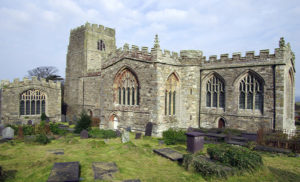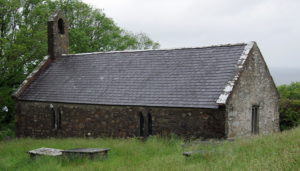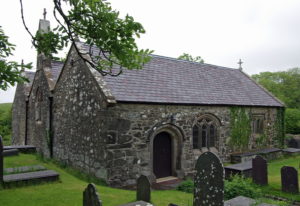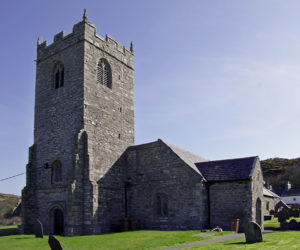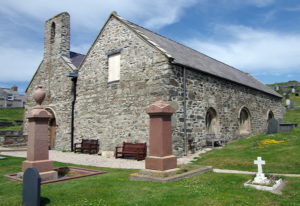Pilgrimage was popular in the Middle Ages and anyone who aspired to be someone went on a pilgrimage. The most important pilgrimage was to the Holy Land, followed by Rome. Not only did these involve a tremendous commitment of time they were also too costly for many to undertake. Bardsey Island, off the tip of the Llyn peninsula in North Wales was the reputed resting place of 20,000 saints. Involving a short but dangerous sea crossing, three trips to Bardsey were regarded as equivalent to one trip to Rome. The pilgrims followed slightly different routes, stopping at a series of pilgrim churches along the way. Many of these were ancient foundations established by C6th saints.
“St Winefride’s Well”:http://wasleys.org.uk/eleanor/churches/wales/other/st_winefride/index.html in Holywell was probably the first stop. This was a site of pilgrimage in its own right with a healing spring.
Around 660AD, St Winefride spurned the advances of Caradoc, son of a local prince as she wanted to become a nun. He cut off her head in his anger. A spring rose from the ground at the spot where her head fell. Winefride was restored to life by her uncle, St Beuno. He called down the wrath of God on Caradoc who was struck dead and swallowed up. Beuno sat on a stone and vowed if anyone sit or stand on that spot and ask God’s help three times in Winefride’s name, that help would be granted. The healing spring is still there and the holy well is still a site of pilgrimage today.
Further west is “St Bueno’s Church “:http://wasleys.org.uk/eleanor/churches/wales/llyn/clynnog_fawr/clynnog_one/index.html in Clynnog Fawr. St Bueno was one of the most important of the early saints and descended from the Princes of Powys. He founded a monastery here in the C7th which became an important centre of learning with the Abbot entitled to a seat in the court of the Princes of Gwynedd. St Bueno was buried here and legends associate him with miraculous healing powers.
When St Bueno wanted peace and quiet, he went on retreat to the tiny”St Bueno’s Church “:http://wasleys.org.uk/eleanor/churches/wales/llyn/pistyll/index.html in Pistyll. This is still a quiet and peaceful spot, set in a hollow below the road, close to the sea with just a farm for company. The building is thought to date from the C12th and, apart from the windows which were added later, is virtually unchanged. The spirit of Celtic Christianity is still strong here.
St Gwynhoedl was another early Celtic saint, reputed to be one of the sons of the Welsh Chieftain Seithenyn. He is buried in the church in “Llangwnnadl”:http://wasleys.org.uk/eleanor/churches/wales/llyn/llangwnnadl/index.html and his shrine was a popular halt on the pilgrim trail.
Pilgrims following the south coast of the Llyn peninsula used churches at Llanor, Llanbedrog, Llangian, Llanengan, Byncroes and Llanfaelrhys. Several of these are kept locked.”St Cian’s Church”:http://wasleys.org.uk/eleanor/churches/wales/llyn/llangian/index.html in Llangian was founded in the C6th by St Peris and his follower St Cian. “St Engan’s Church”:http://wasleys.org.uk/eleanor/churches/wales/llyn/llanengan/lanengan_one/index.html in Llanengan was dedicated to Engan, a local prince. He gave land for “Penmon Priory”:http://wasleys.org.uk/eleanor/churches/wales/other/penmon/index.html in Anglesey and also for the foundation of an abbey on Bardsey Island. There is a holy well in a corner of the churchyard. The tiny church at “Llanfaelrhys”:http://wasleys.org.uk/eleanor/churches/wales/llyn/llanfaelrhys/index.html is dedicated to St Maelrhys, a Breton saint, who was a cousin of St Hywyn.
All the pilgrims collected at “Aberdaron.”:http://wasleys.org.uk/eleanor/churches/wales/llyn/aberdaron/index.html St Hywyn, a 6thC Celtic saint, is thought to have established a small oratory here. Y Gegin Fawr in the centre of the village was a communal kitchen where pilgrims could claim a meal. It is still serving meals today.
Pilgrims often had to wait in Aberdaron for favourable conditions to cross to Bardsey. Accommodation was available at either Y Gegin Fawr or Cwrt Farm, Uwchmynydd. Pilgrims sailed from Porth Meudwy, the small harbour near Cwrt.
Before undertaking the hazardous crossing, they would visited St Mary’s Well located just above high tide on the steep slopes of Mynydd Mawr, with views across to Bardsey. Reached down a very steep path, a fresh water spring flows into a small triangular pool full of green weed. They would drink the water in the hope of a blessing from the Virgin Mary and safe passage to Bardsey.
In the summer months, it is possible to take a”day trip”:https://www.bardsey.org/visit to Bardsey Island, or even stay on the island.
There are more pictures “here.”:http://wasleys.org.uk/eleanor/churches/wales/llyn/index.html
